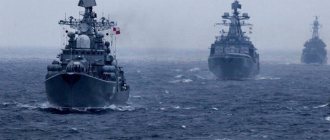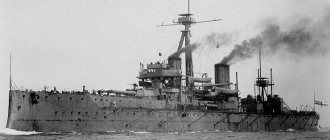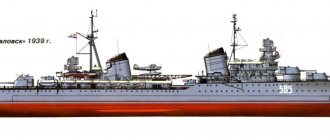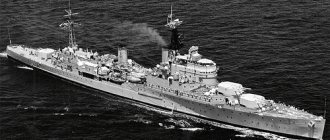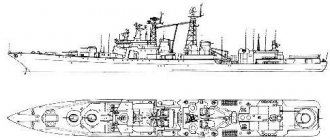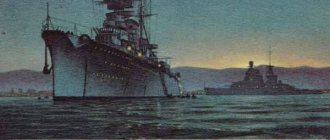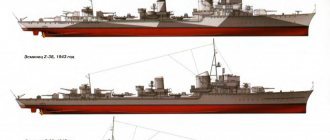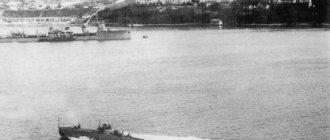In the near future, the Japanese Maritime Self-Defense Force may receive its first aircraft carrier since the end of World War II: the helicopter-carrying ship Izumo will begin to be converted in 2022 to the F-35B short take-off and vertical landing fighters. Japanese media recently reported the acquisition of up to one hundred aircraft of this type.
Administration of the contender: who will become the successor of “Charles de Gaulle”
The French will build their second aircraft carrier by 2040
In the furthest harbors of Russia
Currently, six submarines of Project 877 (Nurlat, Ust-Kamchatsk, Ust-Bolsheretsk, Komsomolsk-on-Amur, Krasnokamensk, Mogocha) and two Project 6363 ( "Petropavlovsk-Kamchatsky", "Volkhov"), missile cruiser Project 1164 "Varyag", destroyer Project 956 "Bystry" (the same type "Burny" is formally under repair, but most likely will be sent for disposal), four BODs ( frigate) pr. 1155 (“Admiral Tributs”, “Admiral Panteleev”, “Admiral Vinogradov”, “Marshal Shaposhnikov”), three corvettes pr. 20380 (“Perfect”, “Gromky”, “Aldar Tsydenzhapov”), four MPK pr. 1124M (“Primorsky Komsomolets”, “Koreets”, “Metel”, “Ust-Ilimsk”), missile boat pr. 1241T and ten boats pr. 12411, base minesweeper pr. 12700 “Yakov Balyaev”, five base minesweepers pr. 1265, one BDK pr. 1171 (“Nikolai Vilkov”) and three pr. 775 (“Peresvet”, “Oslyabya”, “Admiral Nevelskoy”), five landing boats (3 pr. 1176, 1 pr. 11770, 1 pr. 21820).
© RIA Novosti Guards missile cruiser “Varyag”.
All nuclear submarines of the Pacific Fleet are stationed in Kamchatka (in Petropavlovsk-Kamchatsky and Vilyuchinsk). These are three RPK SN (Ryazan, project 667 BDR, Alexander Nevsky and Vladimir Monomakh, project 955A), five SSGNs, project 949A (Irkutsk, Chelyabinsk (both under repair with modernization), Tver ", "Omsk", "Tomsk"), four multi-purpose nuclear submarines pr. 971 ("Bratsk", "Magadan", "Samara" (all three are now being repaired with modernization), "Kuzbass"). In the near future, another “971”, “Nerpa”, will return from Indian lease, but, apparently, “Magadan” will go to India to replace it.
The surface forces of the Kamchatka flotilla are represented by four MRK project 12341 ("Iney", "Moroz", "Razliv", "Smerch"), one MPK project 1124 ("Kholmsk") and three project 1124M (MPK-82, MPK- 107, “Sovetskaya Gavan”), two sea minesweepers pr. 266M and two base mines pr. 1265. In the near future, the corvette pr. 20385 “Gremyashchiy” will join the flotilla.
The two coastal missile brigades have two divisions of the Bal anti-ship missile system and three divisions of the Bastion anti-ship missile missile system, protecting not only Vladivostok and Petropavlovsk-Kamchatsky, but also Kunashir and Iturup.
Almost all of these ships and boats were built in Soviet times and, in fact, are serving out their term.
Recently, the Pacific Fleet received two RPK SN pr. 955 with the Bulava SLBM, but with minimal renewal of general purpose forces, this rather weakened the fleet, since the RPK SN is essentially an element of the strategic nuclear forces, and the Pacific Fleet must use very significant forces to maintain their combat sustainability. Newly built ships also include the submarine Project 6363, corvettes Project 20380/20385 and the only minesweeper Project 12700. In addition, the BOD Project 1155 “Marshal Shaposhnikov” underwent a radical modernization with the installation of “Caliber”, “Onyx” and “ Uranus". Apparently, the same type of Admiral Vinogradov will be modernized according to a similar scheme.
© wikimedia.org
Large anti-submarine ship "Marshal Shaposhnikov".
To say that this is not enough is to say nothing. The situation is aggravated by geographical circumstances. In the event of war, the Pacific Fleet could be completely cut off from European fleets. Moreover, the Primorsky and Kamchatka flotillas of the Pacific Fleet itself will be isolated from each other.
The real state of the Pacific Fleet is especially obvious in comparison with other fleets in this theater of operations.
Rogue Fleet
The Russian Pacific Fleet, as an integral part of the Navy and the Armed Forces of the Russian Federation as a whole, is a means of ensuring Russia's military security in the Asia-Pacific region. The basis of the fleet's combat forces is made up of more than 70 vessels - from diesel-electric missile-torpedo submarines to missile cruisers and destroyers.
At first glance, the list is more than impressive. But this is only the initial impression.
“Almost all the ships and boats in the Pacific Fleet were built in Soviet times and, in fact, are serving out their useful life. Throughout the entire post-Soviet history, the Pacific Fleet, in fact, has been in the role of an outcast,”
— Deputy Director of the Institute of Political and Military Analysis Alexander Khramchikhin tells Gazeta.Ru.
The expert says that in the 90s and 2000s, the Russian Navy received an extremely small number of ships and boats, while all of them went to the Northern and Baltic fleets, as well as to the Caspian flotilla. In 2010, the renewal of these naval formations accelerated, and after the Crimean events of 2014, the rapid rearmament of the Black Sea Fleet began.
“The Pacific Fleet was completely forgotten. True, it received two strategic missile submarine cruisers (RPK SN) of Project 955 with the Bulava SLBM, but in the absence of renewal of general purpose forces, this rather weakened the fleet, since RPK SN is essentially an element of strategic nuclear forces, and the Navy must use very significant forces to maintain their combat stability. Only in recent years, the Pacific Fleet received two submarines of Project 636.3 and 4 corvettes of Project 20380, but this is almost nothing, especially considering the fact that corvettes are, to put it mildly, not outstanding ships due to the extreme weakness of air defense.
The number of modern units in the Pacific Fleet’s combat strength is not even equivalent to a flotilla,” says Khramchikhin.
“The existing ship composition of the Pacific Fleet in no way meets the modern needs of the theater of military operations,” Maxim Klimov, an independent expert in the field of the navy, tells the publication. — For comparison, China’s “shipbuilding conveyor belt” is located nearby. Just one example - in 9 years (this is slightly more than the period of construction of the Project 20380 corvette in Russia), the PLA Navy received 72 Type-056A corvettes (22 Type-056 and 50 Type-056A). And the point here is not only in China’s powerful shipbuilding industry, but primarily in a well-thought-out and realistic shipbuilding program.”
Japan Maritime Self-Defense Force
The Japanese Navy (this country, as you know, has open territorial claims against Russia) is one of the five strongest in the world.
The Japanese submarine fleet consists only of diesel (non-nuclear) submarines, it includes one Taigei-class submarine, twelve Soryu-class submarines, nine Oyashio-class submarines (2 more are used as training ones); one Harushio-class submarine is used as an experimental submarine.
All large surface ships of the Japanese Navy are classified as destroyers, which in some cases is quite strange, since, in addition to actual destroyers, this also includes aircraft carriers (helicopter carriers), cruisers and frigates.
"Destroyer" helicopter carriers - two ships of the Izumo type and two of the Hyuga type. Hyuga-class ships are light aircraft carriers in size and architecture, theoretically capable of carrying up to 10 VTOL aircraft. “Destroyer”-helicopter carriers of the “Izumo” type are practically full-fledged aircraft carriers (their length is almost 250 m), and, like any classic aircraft carriers, they have almost no weapons of their own (except for a few air defense systems for immediate self-defense). Now they are based on 14 helicopters. The upcoming purchase of American F-35B VTOL aircraft will make the ships “real” aircraft carriers.
The "destroyers" are essentially cruisers - two Maya-class ships, two Atago-class ships and four Kongo-class ships. All are equipped with the Aegis system and Mk41 UVP, thanks to which they can be an integral part of the naval missile defense component.
© mod.go.jp/msdf
Fuyuzuki is a modern Japanese Akizuki-class destroyer.
Among the destroyers themselves, the most modern are 18 ships of three types, which are actually three modifications of one project (four Akizuki type, five Takanami type, nine Murasame type), as well as two Asahi-class destroyers. There are also older destroyers: eight Asagiri-class and three training destroyers - one Hatsuyuki-class and two Hatakaze-class. Finally, “escort destroyers”, i.e. frigates - six Abukuma-class ships, construction of Mogami-class frigates has begun.
The Japanese Navy also includes six Hayabusa-class missile boats, up to thirty minesweepers, and three Osumi-class diesel-propelled gunships. The latter have significantly increased the landing capabilities of the Japanese fleet, but in general they remain very limited; the Navy and Self-Defense Forces as a whole are not capable of conducting serious landing operations. However, ships of the Izumo type can also be used as UDCs.
Thus, if under water the Pacific Fleet is not much inferior to the Japanese Navy, then in surface forces the advantage of the Japanese, admittedly, is overwhelming.
DESTROYERS URO
Atago type There are two destroyers in service - Atago (2007) and Ashigara (2008)
Total displacement – 10,000 tons. Armament: 96 UVP Mk.41 cells, 8 SSM-1B anti-ship missiles, 1 x 127 mm gun, 2 Phalanx assault rifles, 2 Mk.32 ASW torpedo tubes, one helicopter. Atago is a clone of the American destroyer Arleigh Burke of subseries IIa with minimal differences in design and armament. The Japanese destroyer uses the entire standard range of Mk.41 PU ammunition with the exception of Tamahawk cruise missiles - the destroyer's armament complex includes Standard-2 and ESSM anti-aircraft missiles, ASROC-VL anti-aircraft missiles and even Standard-3 missile defense interceptor missiles. On the upper deck of Japanese ships, unlike their modern American counterparts, 8 SSM-1B anti-ship missiles manufactured by Mitsubishi are installed. In technical terms, they are conventional subsonic anti-ship missiles: launch weight 660 kg, warhead 250 kg, cruising speed 0.9 Mach.
Thanks to the presence of the Aegis system, both newest destroyers are integrated with Japan's missile defense system.
Republic of Korea Navy
Just 30 years ago, the Republic of Korea Navy was a dump of American scrap metal built in the 1940s and 1950s. Today, the South Korean fleet is perhaps stronger than any European one, and, like the Japanese Navy, almost all ships are built at their own shipyards and mainly according to their own designs.
The submarine fleet of the Republic of Kazakhstan includes 18 German submarines (but they were built in Korea) - 9 Project 209/1200 and 9 newest Project 214/1700.
There are 12 self-built destroyers: three Sejong Daewan types, six Chungmugon Lee Sunsin types, three Gwanggaetho types. The most modern of them, the Sejong Daewan, are the world's most powerful non-carrier surface warships. These ships, equipped with the Aegis system, are armed with 80 Standard missile launchers, 32 Hyungmu-3 SLCMs (comparable in performance characteristics to the Tomahawk, although they have a shorter flight range) and 16 Red Shark anti-ship missiles ", as well as 4x4 PU PKRK "Haesong". It should be noted that all of these missiles, except for the Standards, are of our own design, albeit with American “influence.”
Ulsan-class frigates (4 units) are considered obsolete. To replace them, six Incheon-class frigates were built, and construction began on ships based on an improved project of the Daegu class (there are currently 2, there will be 8 in total). All of them are armed with the Hyunmu-3 SLCM.
© navy.mil.kr
Ships of the Navy of the Republic of Korea on a voyage.
There are eleven Pohang-class corvettes, eighteen of the newest Yun Yunha-class corvettes. All corvettes are armed with anti-ship missiles. The construction of a series of attack boats “Chamsuri-211” (a smaller version of the Yun Yunha corvettes) has begun; there are now nine such boats. The number of patrol boats reaches 120 units. The mine-sweeping force includes two mines and nine minesweepers.
The landing forces consist of the Dokdo landing craft (sometimes classified as UDC, another one is being built), four Go Zhong Bon type TDKs and four Chong Wan Bon types, as well as five hovercraft landing craft, including h. three project 12061 “Moray eel” of Russian construction.
Thus, the ratio of the potentials of the Pacific Fleet and the South Korean fleet is the same as in the case of the Japanese fleet: under water there is something like equality, in terms of surface forces there is an overwhelming superiority of the Koreans.
Russia. Revival and augmentation of the former formidable power
The Russian Navy is the successor to the USSR fleet, which once shared first place with the US Navy. Original finds, unusual approaches to warfare, the best school for creating anti-ship missiles, unique titanium submarines. The USSR had all this. But since the early 1990s, due to funding problems, the Russian fleet has shrunk significantly in size. Many ships fell into disrepair and were scrapped. Only in the last two decades has it begun to be replenished with new ships with modern weapons, mainly submarines. The Russian Navy is experiencing problems with the construction of new ships of the first rank (cruisers, destroyers, aircraft carriers), but the efforts made and innovative technologies allow it to maintain second place in the rating.
The personnel of the Russian Navy number about 140,000 people. The Russian fleet has a single aircraft carrier at its disposal, which is inferior in performance to the newest American aircraft carriers and can accommodate fewer aircraft. At the moment, the ship is undergoing repairs and modernization due to problems with the propulsion system.
The flagship of the Russian fleet is a heavy nuclear-powered missile cruiser. Also in the fleet are 3 smaller guided missile cruisers, which have significant anti-ship, anti-aircraft and anti-submarine capabilities. The Russian Navy has 15 destroyers, 9 frigates and 24 corvettes.
The Russian marine corps is quite small and numbers only about 12,000 people. To deliver it to the shore, 20 landing ships of different classes are used. These combat vessels are maneuverable and capable of ultra-long voyages, but are much smaller in size than their American counterparts.
The Russian Navy operates a number of nuclear submarines, which are considered its pride. These are the largest submarines ever built, designed to attack strike groups of American aircraft carriers and coastal targets. There are a significant number of diesel submarines in service, used for the defense of naval bases. Russia is investing heavily in creating new submarines that can carry intercontinental missiles with nuclear warheads.
Naval aviation has about 360 aircraft, including anti-submarine and tactical bombers.
On paper, the Russian fleet is inferior to the Chinese in terms of the number and tonnage of ships. However, it is armed with a number of proven ballistic missile submarines, and also introduces the latest technologies that are significantly superior to their global counterparts.
US Navy in the Pacific
To compare the Pacific Fleet of the Russian Federation and the United States is, to a certain extent, a “blasphemous” activity. But for reference, we can report that in the Pacific Ocean the US Navy has eight SSBNs and two Ohio-class SSGNs, twenty-six submarines (3 Sea Wolf-class, 6 Virginia-class, 17 Los Angeles-class), five nuclear-powered aircraft carriers of the Nimitz type, twelve cruisers of the Tyconderoga type, thirty-seven destroyers of the Orly Burke type and two of the Zamvolt type (all cruisers and destroyers are equipped with the Aegis system and UVP for SLCMs and missiles), fourteen or frigates , or LCS class corvettes (2 Freedom type, 12 Independence type), nine Avenger type minesweepers (4 more in reserve), six UDC (2 America type, 4 Wasp type), seven San Antonio-class landing craft, four Whidbey Island-class landing craft and two Harpers Ferry-class landing transports.
© cpf.navy.mil
US Navy forward-deployed aircraft carrier, USS Ronald Reagan (CVN 76) in the South China Sea.
The Republic of Korea and Japan are the closest allies of the United States; if you add up their Navy with the American Pacific Fleet and compare it with our Pacific Fleet, then the enemy’s superiority will not even be several times, but orders of magnitude, especially in terms of surface forces. True, it should be noted that of all the close allies of the United States, there are only two countries that did not impose any, even purely symbolic, sanctions against Russia in 2014 and in subsequent years: these are Israel and, precisely, the Republic of Korea.
For several reasons, Seoul categorically does not want to quarrel with Moscow (let alone fight with it), while it is in extremely difficult relations with Tokyo. But even if we do not consider the Koreans as opponents, the superiority of the sum of the US Pacific Fleet and the Japanese Navy over the Russian Pacific Fleet will be colossal.
DESTROYERS
Type "Akizuki" The lead "Akizuki" entered service on March 14, 2012, the remaining 3 destroyers of this type will be completed only by 2014.
Displacement: 6800 tons Armament: 32 UVP Mk.41 cells, 8 SSM-1B anti-ship missiles, 1 x 127 mm gun, 2 Phalanx assault rifles, 2 ASW, one helicopter.
Another representative of the Aegis destroyer family. Purely Japanese development based on Western technologies. Designed to defend naval groups from low-flying anti-ship missiles. The main armament is up to 128 ESSM (Evolved Sea Sparrow Missle) anti-aircraft missiles with an effective firing range of 50 km. It is quite enough to repel any provocation from the DPRK or China, while a small destroyer can show its own “fists” - on board 8 anti-ship missiles and a whole sea of other weapons.
When creating a promising destroyer, the Japanese focused on saving money; as a result, the cost of the Akizuki was “only” $893 million - almost half that of the destroyers of the Arleigh Burke family.
Takanami type
There are 5 destroyers in service, built from 2000 to 2006.
Total displacement – 6300 tons. Armament: 32 UVP cells, 8 SSM-1B anti-ship missiles, 1 x 127 mm gun, 2 Phalanx assault rifles, 2 ASW, one helicopter. "Takanami" is one of the Japanese destroyers of the "transition period". The expensive and complex Aegis system is missing, but the destroyer is already equipped with a universal Mk.41 launcher, and “stealth technologies” are clearly visible in the configuration designs.
The main tasks of strong modern destroyers are anti-submarine defense and anti-surface warfare.
Murasame type
Between 1993 and 2002. 9 destroyers of this type were built
Total displacement: 6000 tons Armament: 16 UVP Mk.48 cells, 8 SSM-1B anti-ship missiles, 1 x 76 mm gun, 2 Phalanx assault rifles, 2 ASW, one helicopter. Another destroyer of the “transition period”. The main weapons are two 8-charge UVP Mk.48 modules (a shortened version of the Mk.41), ammunition for 16 Sea Sparrow anti-aircraft missiles or 48 ESSM. Artillery is represented by a single 76 mm gun from the Italian company OTO Melara. Destroyers of this type can be used to blockade sea areas and act as part of escort forces - their cruising range is 4,500 miles at a speed of 20 knots.
Asagiri type
From 1985 to 1991 8 destroyers of this type were built
Total displacement: 4900 tons Armament: 8 ASROC anti-submarine missiles, 8 Harpoon anti-ship missiles, Sea Sparrow air defense missile system, 1 x 76 mm gun, 2 Phalanxes, 2 ASW, one helicopter. A frigate pretending to be a destroyer for the sake of appearance. Neither in size, nor in armament, nor in radio electronics, “Asagiri” does not at all meet modern requirements. A distinctive feature of this ship is its ugly silhouette with a disproportionately large helicopter hangar at the stern.
Currently, obsolete destroyers are being withdrawn from the fleet, two of them have already been converted into training ships. However, the mechanisms of old destroyers still have their resource for going to sea, and 8 eight Harpoon missiles and an anti-submarine helicopter can play a significant role in a naval battle.
Type "Hatsyuki"
In the period 1980-1987. 12 ships built
Total displacement: 4000 tons Armament: 8 ASROC anti-submarine missiles, 4 Harpoon anti-ship missiles, Sea Sparrow air defense missile system, 1 x 76 mm gun, 2 Phalanxes, 2 ASW, one helicopter. A representative of the old Japanese school of shipbuilding, a classic set of weapons and ship systems. Despite the dilapidation, the destroyers (more correctly, frigates) use a modern gas turbine power plant. Of course, in modern conditions, the Hatsuki destroyers have lost their combat value, so many of them have been put into reserve or converted into training ships.
Chinese Navy: Red Dragon prepares to jump
It is even more blasphemous to compare the Russian Pacific Fleet with the Navy of our “strategic ally”, i.e. China. The pace of work of the current Chinese shipbuilding conveyor in peacetime has no analogues. Only the American conveyor belt worked faster during the Second World War, but then, firstly, there was a war, and secondly, the ships were still much simpler than the current ones.
In just a quarter of a century, the Chinese fleet has transformed from a coastal squalor with a quality level, at best, of the 1960s, into a powerful modern ocean fleet, second only to the American one, and even then only for now.
The naval component of the Chinese strategic nuclear forces for a long time consisted of one very primitive SSBN Project 092 “Xia” (it is still in service). Currently, two much more modern SSBNs, Project 094 Jin, and five Project 094A have been built. To replace the obsolete Project 091 Han submarines (five were built, but two have already been decommissioned), three Project 093 Shan submarines and five Project 093A submarines were built. Construction of submarines pr. 095 is underway, comparable in their performance characteristics to the most modern American and Russian submarines.
The Chinese fleet of diesel submarines is the largest in the world. The most modern of them are eighteen submarines of Project 039A/B "Yuan" (4 A, 14 V) with an air-independent power plant (we still do not have submarines with VNEU in service). Twelve Russian-built submarines are considered fairly new - two Project 877, two Project 636, eight Project 636EM with 3M54E Caliber anti-ship missiles. In addition, in the early 2000s, thirteen submarines of Project 039 “Song” were built. Thirteen submarines of Project 035 “Min” are older, but still combat-ready.
© chinamil.com.cn
The aircraft carrier Liaoning with a battle group of missile destroyers and frigates.
The first Chinese aircraft carrier, Liaoning, is a former Soviet aircraft-carrying cruiser, Varyag, acquired by the PRC from Ukraine in an unfinished state. The Shandong aircraft carrier was built according to a similar project in China itself. At least two even larger aircraft carriers are being built.
In the 1990s and early 2000s. China acquired four destroyers from Russia - two Project 956, two Project 956EM (in recent years they have undergone radical modernization with the replacement of anti-ship missiles with Chinese ones). At the same time, seven destroyers of four different projects were built in China itself: two Project 051C, one Project 051B, two Project 052B, two Project 052. Then the construction of truly modern destroyers Project 052C/D began in China. Six destroyers of Project 052C have been built, nineteen destroyers of Project 052D are also in service, and in total at least twenty-five ships of this type will be built.
It should be emphasized that China has already technologically surpassed Russia and almost all European countries in the development of large surface ships and has reached the level of the three most advanced countries in this area - the USA, Japan and the Republic of Korea.
This is evidenced by the presence on the destroyers of Project 052C (from the third ship) and Project 052D (on all) of radar with phased array and “classic” UVP such as the American Mk41. On the previous destroyers of Project 051 and 052 (including the first two Project 052C) Russian drum-type UVPs were installed (as on the cruisers of Project 1164), in which only one missile out of eight was ready for launch at a time, and these UVPs were designed for only one type of missiles (missiles for the S-300F air defense system). On new Chinese destroyers, UVPs are installed, in which all missiles are ready for launch at the same time, and on destroyers of Project 052D these can be missiles of different types and classes. These ships have a launcher for 64 missiles (SLCM, anti-ship missiles, missiles and anti-ship missiles). This provides destroyers with the ability to strike both sea and coastal targets, as well as carry out air defense of naval formations.
© chinamil.com.cn
Integrated supply ship Honghu (hull 963), guided-missile destroyer Hefei (hull 174), guided-missile frigate Yuncheng (hull 571) and naval transport dock Changbaishan (hull 989).
Three destroyers of Project 055, which are, in fact, cruisers (have a bow launcher for 64 missiles and a stern for 48 missiles), have been commissioned; five more ships of the same type are being tested or are being built. In terms of their potential, the 055s are equal to the aforementioned South Korean destroyers of the Sejong Taewan class, i.e. are the most powerful non-carrier surface ships in the world.
The most numerous class of surface ships of the PLA Navy are frigates. The ships of Project 053N were built in seven modifications. Eight frigates, Project 053N3, two Project 053N1G, and one Project 053N1, remain in service. To replace the ships of Project 053N, two frigates of Project 054 and thirty frigates of Project 054A were built. Along with the traditional strike weapons for the PLA Navy (8 S-803 anti-ship missiles in container launchers), Project 054A ships became the first Chinese frigates to have adequate air defense for ships of this class: air defense for 32 HHQ-16 missiles (created on the basis of the Russian Shtil air defense system "). Thanks to this, these frigates are universal escort ships that can be used to guard aircraft carriers near their shores and to reinforce groups of destroyers in the open ocean. At least twenty more ships of Project 054A will be built.
In 2012, China began construction of Project 056 ships, which are classified either as small frigates or corvettes. Currently, seventy-two ships of this type have been commissioned, i.e. they were built at a rate of 8 units per year. At this point, the series appears to be complete.
Although in the last decade and a half the Chinese fleet has changed from a “mosquito” (coastal) fleet to an ocean-going fleet, it remains in first place in the world in terms of the number of combat boats. Thus, there are more than a hundred missile boats: eighty-three Project 022, eighteen Project 037-IG, six Project 037-II. Boats pr. 022 are not only the most numerous, but also the most powerful and modern in their class in the world. They are built on the basis of high-speed catamarans of the Australian company Austal, each carrying 8 YJ-83 anti-ship missiles. There are at least one hundred patrol boats in the PLA Navy.
The mine-sweeping forces are represented by nine newest minesweepers of Project 082-II, four minesweepers of Project 082 and 12 minesweepers of Project 082-I, four minesweepers of Project 081 and ten minesweepers of Project 081A.
© chinamil.com.cn
The amphibious landing ships Wuzhishan (hull 987), Kunlunshan (hull 998) and Changbaishan (hull 989).
The landing forces of the PLA Navy include UDC Project 075, eight DTD Project 071, thirty TDK Project 072 of three modifications (11 Project 072-III, 15 Project 072A, 4 Project 072-II), fourteen medium landing ships of Project 072-III. 073 (10 project 073A, 1 project 073-III, 3 project 073-II), about sixty small landing ships.
Oddly enough, quite a few people in Russia are confident that China will fight shoulder to shoulder with the Russian Federation against the United States and/or Japan. In fact, in Beijing they don’t even consider this option and, rather, would prefer to watch such a conflict from the sidelines, and then profit at the expense of the loser - in accordance with the well-known Chinese stratagems “Kill with someone else’s knife”, “Watch the fire from the other side” , “Rob during a fire”...
Hatakaze type
2 destroyers of this type entered service in 1986 and 1988.
On a friendly visit to Pearl Harbor
Total displacement - 5500 tons Armament: 1 Mk.13 launcher with ammunition of 40 anti-aircraft missiles, 8 ASROC anti-ship missiles, 8 Harpoon anti-ship missiles, 2 x 127 mm guns, 2 Phalanxes, 2 ASW.
Despite their status as "guided missile destroyers", the old Hatakaze galoshes are practically useless in modern conditions - suffice it to say that the Standard-1MR anti-aircraft missiles they used were completely removed from service with the US Navy 10 years ago. Their anti-submarine capabilities also leave much to be desired - the destroyers do not have an anti-submarine helicopter, and the ASROC system can hit underwater targets at a distance of no more than 9 km.
At the same time, Hatakaze destroyers are cheap and easy to maintain.
We play in our own league...
In fact, the Pacific Fleet today is “in the same league” not with the navies of the USA, China, Japan and the Republic of Korea, but with the navies of Taiwan, Thailand, North Korea, and Vietnam. Yes, it is very difficult (or even impossible) to imagine these countries as our opponents, but regardless of this, the current position of the Pacific Fleet in the world table of ranks is not the highest. To a lesser extent, this applies to the entire Eastern Military District as a whole. But, unfortunately, we still have an abnormally large number of people who believe in the “strategic partnership” with China, and, perhaps, it is this amazing belief that has become one of the main reasons for the lack of attention to military development in the Asian part of the Russian Federation.
In fact, today Russia has a “European army”, well armed and ready for war with any enemy. And there is an “Asian army”, which, unfortunately, is very close to the Soviet times. This should not be the case under any circumstances; it must be corrected as quickly as possible. Simply because the “center of the world” is no longer located in the Euro-Atlantic region. He moved to the Asia-Pacific region a long time ago. Only we hardly noticed it.
